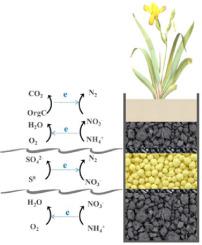Water Research ( IF 11.4 ) Pub Date : 2021-03-02 , DOI: 10.1016/j.watres.2021.116996 Meng Li , Rui Duan , Wen Hao , Qingcheng Li , Panpan Liu , Xiang Qi , Xia Huang , Xiaoqiang Shen , Ruifeng Lin , Peng Liang

|
To investigate the role of granular activated carbon (GAC) on nitrogen removal performance of elemental sulfur-based constructed wetlands (S0-based CWs), three systems were constructed according to the different configurations in the functional layer, namely S-CW (S0 added in the functional layer), CSC-CW (GAC, S0 and GAC placed in layers in the functional layer) and SC-CW (S0 and GAC mixed evenly in the functional layer). In CSC-CW and SC-CW, the volumetric ratio of S0:GAC was 9:1. Three CWs were operated under four different hydraulic retention times (HRTs) ranged from 48 h to 6 h. Over the experiment, total inorganic nitrogen (TIN) removal rates of the three CWs were 3.1 – 23.6 g m−2 d−1, 3.5 – 24.1 g m−2 d−1 and 3.4 – 11.5 g m−2 d−1, respectively; CSC-CW remained high TIN removal efficiency (from 74.7 ± 20.2 % to 93.4 ± 1.9 %) while SC-CW had significant lower values when HRT = 6 h (29.8 ± 30.1 %). Mass balance and high-throughput sequencing analysis revealed that mixotrophic denitrification at the sulfur layer and simultaneous nitrification-denitrification (SND) at the rhizosphere played the major role in N removal from CSC-CW (> 95 %). GAC addition facilitated the growth of Iris pseudacorus with the final fresh weight increased from 33.9 gFW ind−1 to 82.3 gFW ind−1 in CSC-CW and 82.7 gFW ind−1 in SC-CW. This study optimizes the practical application of S0-based CWs amended with GAC for N removal from carbon-limited wastewater.
中文翻译:

颗粒活性炭改良人工湿地中元素硫的高效脱氮
为了研究粒状活性炭(GAC)在单质硫基人工湿地(S 0型CW)的脱氮性能中的作用,根据功能层中的不同配置构建了三个系统,即S-CW(S在功能层中添加0),CSC-CW(GAC,S 0和GAC置于功能层中)和SC-CW(S 0和GAC在功能层中均匀混合)。在CSC-CW和SC-CW中,S 0 ∶GAC的体积比为9∶1。三个CW在48 h至6 h的四个不同的水力停留时间(HRT)下运行。在整个实验过程中,这三个化学废物的总无机氮(TIN)去除率为3.1 – 23.6 gm -2d -1,3.5 - 24.1克-2 d -1和3.4 - 11.5克-2 d -1,分别; CSC-CW保持较高的TIN去除率(从74.7±20.2%到93.4±1.9%),而HRT = 6 h时,SC-CW的值明显较低(29.8±30.1%)。质量平衡和高通量测序分析表明,硫层上的混合营养反硝化作用和根际上同时硝化-反硝化作用(SND)在CSC-CW脱氮(> 95%)中起主要作用。GAC的添加促进了鸢尾鸢尾的生长,最终鲜重从33.9 g FW ind -1增加到82.3 g FW ind -1CSC-CW中的重量和82.7 g FW ind -1在SC-CW中。这项研究优化了经GAC修正的基于S 0的CW的实际应用,可从限碳废水中去除N。











































 京公网安备 11010802027423号
京公网安备 11010802027423号